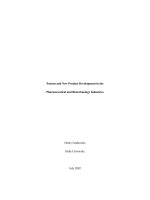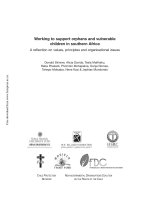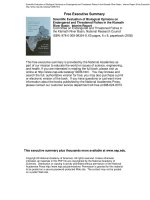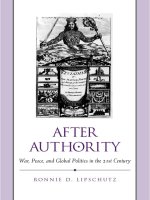Enhancement of technology from old preservatives to new preservatives and latest development in the field of preservation
Bạn đang xem bản rút gọn của tài liệu. Xem và tải ngay bản đầy đủ của tài liệu tại đây (193.2 KB, 10 trang )
Int.J.Curr.Microbiol.App.Sci (2019) 8(1): 2173-2182
International Journal of Current Microbiology and Applied Sciences
ISSN: 2319-7706 Volume 8 Number 01 (2019)
Journal homepage:
Review Article
/>
Enhancement of Technology from Old Preservatives to New Preservatives
and Latest Development in the Field of Preservation
Sonia Panigrahi1* and Sadhna Tripathy2
1
M.S.Swaminathan School of Agriculture, CUTM, Paralakhemundi-761200(Odisha), India
2
Forest Product Division, Forest Research Institute, Dehradun- 248195, India
*Corresponding author
ABSTRACT
Keywords
Chromated Copper
Arsenate (CCA),
Acza, Electro
pulsing technology,
Creosote oil
Article Info
Accepted:
14 December 2018
Available Online:
10 January 2019
Wood preservatives are usually protecting the wood products from deterioration. Various
methods of treatment can be practiced to incorporate the preservatives inside the wood
depending upon the application of end product. Ultimately the preservative enhance the
dimensional properties and provide resistance to wood products from biological pathogens.
Improvement in the present situation of wood preservation in tropical countries would
result in a great reduction of wood losses. Losses resulting from lack of preservation are
strikingly high compared with the costs of preservation. Chemical and thermal
modification are the most popular method of treatment from 20th century. The greatest
impact on wood preservation in the 20th century is the invention of Chromated copper
arsenate (CCA) preservatives which is gaining a lot of attention afterwards. The
preservative used earlier are oily liquid preservatives like creosite, creosote oil and coal
tar, petroleum but application of modern technology in the latest developed preservatives
have grate efficiency over the earlier.
Introduction
Wood preservation was first introduced as an
industrial process in England and it has
continued to be used in situation where decay
is otherwise inevitable such as for railway
sleepers and transmission pole. It must be
accepted that wood decay is inevitable for
example- fungal decay is dependent on
moisture content, so that a structure designed
to maintain wood in a dry condition is
sufficient to ensure freedom from fungal
decay, whatever the species of wood. The
preservative treatment required in wood to
increase the lifespan of the material and
reduce the replacement of the material. But
preservation involves additional cost and must
clearly be justified. The environmentalist may
see preservation as a mean for reducing our
demand for replacement wood, thus
conserving our forest. Wood importing
countries will wish to reduce wood import as
to reduce currency while the wood exporting
countries will adopt preservation in order to
reduce home demand for replacement wood,
thus leaving the maximum volume available
for export. Wood preservation is the pressure
or thermal impregnation of chemicals into
2173
Int.J.Curr.Microbiol.App.Sci (2019) 8(1): 2173-2182
wood to a depth that will provide effective
long-term resistance to attack by fungi, insects
and marine borers. By extending the service
life of timber, wood preservation reduces the
harvest of valuable forestry resources, reduces
operating costs in industries such as utility and
railroads, and ensures safe conditions where
timbers are used as support structures. In
addition to industrial and commercial
application, a significant part of the treated
wood volume is used for residential
construction
to
protect
homeowners'
investments and provide outdoor living spaces
that are a desired part of the Canadian way of
living. As indicated earlier, these costs show
that the average cost of wood preservation in
tropical countries may amount to about 20 to
30 percent of the cost of the timber used and
that the service life of treated wood may be 5
or more times as long (Swiderski, 1997). The
use of preservative chemicals and treated
wood has been and still is sometimes
criticized on the basis of health or
environmental concerns. Ignorance on the part
of the treating industry, poor work practices
and lax environmental regulation all share part
of the blame for that negative perception.
Innovation in the first half of the 20th century
led to the development of more effective wood
protecting
chemicals
and
processing
techniques that turned a specialty industry into
a commodity business (Preston, 2000). As can
happen in all commodity businesses, research
and development was not sustained when
profit margins began to fall and the door was
opened for competitive products such as
plastics, concrete and steel (Kevin Archer and
Stan Lebow, 2006).
About wood preservatives
Some species are naturally durable as the
Sapwood is rarely durable, the heartwood of
many tree species exhibits some degree of
resistance to attack by decay fungi and insects,
This natural durability can be attributed to a
combination of toxic extractives present in the
wood and low inherent permeability. As a
result of this natural durability such woods can
be used outdoors and in some cases in ground
contact or submersed in water. Wood from
naturally durable species is sometimes viewed
as being environmentally preferable to
chemically treated wood, and many of these
species have an attractive appearance. In
addition, some species such as black locust,
greenheart and ipe also have excellent strength
properties (Green et al., 1999). As might be
expected such a combination of desirable
attributes has led to increasing interest in use
of durable species from the tropical countries
for construction in North America and Europe.
However, several factors limit the use of
naturally durable species. In developed
countries the volume of growing stock of
naturally
durable
species
is
relatively low compared to the demand for dur
able wood products.(www..fpl.fs.fed.us/docu
mnts/pdf2006/fpl_2006_archer001.pdf).
In
view of the limited supply of natural durable
wood species, it is valuable to supply of less
durable wood treated with preservatives.
Preservatives treatment of timber therefore it
is important to conserve the wood sources of
the country.
Wood preservatives are chemical substances
that when suitably applied to wood, make it
resistance to fungi, insect and woodborer.
There are two general classes of wood
preservatives: oils, such as creosote and
petroleum solutions of pentachlorophenol; and
waterborne salts that are applied as water
solutions.
The
effectiveness
of
the
preservatives varies greatly and can depend
not only upon its composition, but also upon
the quantity injected into the wood, the depth
of penetration, and the conditions to which the
treated material is exposed in service (Wood
Preserving Industry Production Statistical
Report, 1996).
2174
Int.J.Curr.Microbiol.App.Sci (2019) 8(1): 2173-2182
The choice of wood preservatives depends
upon the character of the wood to be treated,
the anticipated service and the properties of
the chemical or formulation. Wood
preservation formulations must:
ingredients of most preservatives are potent,
capable of causing poisoning as small as a few
drops or few grams.
protect against attacking organisms;
be able to penetrate wood;
remain in the wood for the length of the
intended service;
be chemically stable;
be safe to handle;
be economical to use; preservatives are two
types either oily liquids or metallic
compounds.
In Europe the first attempt were taken by
placing of stone blocks under wooden pillars
to keep away soil and vegetation.
Major used wood preservatives are:Pentachlorophenol
Creosote
Inorganic salts
Amonical cupper arsenate
Chromate cupper arsenate- Acid cupper
chromate
Chromate zinc chloride
Preservatives used earlier
Later on olive oil or other essential oil were
used as they kept the wood free from insect
attack.
M. Paulet in his book entitled “conservation
des Bios” enumerates 173 processes or
methods that were tried, most of which proved
unsuccessful. It was during the 1st quadrate of
the 19th century that modern methods of
injecting wood may be considered as
beginning although the most successful
attempts did not come until a few years later.
Mercuric chloride was used by Homberg in
1705 and by De Boissiew in 1967.The use is
commonly called kyanizing.
Minor used wood preservatives
Copper sulphate recommended by De
Boissiew and Bordenava in 1967 and best
known as margaryzing.
Copper naphthenate
Copper 8
Tributyltin oxide
Chloride of zinc recommended in 1815 by
Thomas Wade and by Boucherie in 1837 and
referred as burnettizing (Samuel B. Boulton,
1885)
New preservatives
Alkylammonium compounds(AAC)
Di –alkyl dimethyl ammonium
Advantages of wood preservatives are
clean, colourless, odourless and paintable.
They should not cause more than
minimal swelling.
The treatment of green timber with creosote
by first using steam followed by a vacuum
prior to impregnation with the oil is attributed
to Hayfor (Jornal of Franklin institute, 1878).
Oily liquids preservatives used earlier
A wood preservatives must be toxic to
the insect, pest, fungi, borer. It must be able
to be absorbed and held by the wood so that it
does not leach out into the environment. The
Creosote oil, carboleneum, shale oil used as
wood preservatives in 1848 suggested by
Hutin and Boutigny in 1848.
2175
Int.J.Curr.Microbiol.App.Sci (2019) 8(1): 2173-2182
The chemicals recommended in the year and used in various countries
CHEMICALS
YEAR
1919
Creofixol
Creosote oil + coal tar + 1920
petroleum
1922
Creosite
Metallic compounds
CHEMICALS
YEAR
1705
Mercury chloride
1838
Copper sulphate
1907
Aczol
1932
Boliden salt
Chromate zinc chloride 1934
World war 2
Zinc sulphate
19th century
Florine
Inorganic compounds
Boron compound – used as fire retardants in
wood (1933).
Chromium compound – used as admixtures in
water soluble preservatives salts (1938).
Organic compounds
Chlorinated phenols, Chlorinated cresols and
xylonols, Chlorinated napthalenes (1913),
Nitrated phenols and cresols-19th centuries,
Chlorinated benzenes (1940 onwards),
dichloro diphenyl-trichloroethane (DDT),
Organic mercury compounds (Brosevan
Groenou et al., 1952).
Preservatives used presently
Oil and oil borne preservatives used are the
Coal tar, creosote solution, petroleum fuel oil.
The principal toxic chemical used is
pentachlorophenol. It has very low solubility
in water and low volatility and is very stable
chemical therefore it is most promising and
widely used preservatives of oil borne
COUNTRY
Europe
Belgium
Scotland
USA
chemical type. Demerits - It has been found
ineffective against marine borers and never
used for the protection of wood in salt water.
Waterborne preservatives used are arsenic
salt, borax and boric acid, chromium salt,
cupper sulphate, mercuric chloride, nickel
salt, sodium chloride, zinc chloride
Demerits - These are highly toxic to the
human body and animal. (Ref:-Gorge M.
Hunt and George A. Garratt 1953)
In European country wood preservatives are
used –
In England creosoting is most popular
method, in Germany creosote and zinc
chloride are extensively used. In France the
timbers and poles are impregnated with
copper sulphate, in United states modern
preservation begins in the country in 1875
creosoting is the popular method (Howard F.
Wiess).
In United States zinc chloride, creosote,
coaltar, carbonelium salt. The production of
low temperature coal tar, creosote in 1950
was negligible in the USA but in England it
2176
Int.J.Curr.Microbiol.App.Sci (2019) 8(1): 2173-2182
was used. The incising of poles is confined to
northern white cedar and western red cedar
and also for Douglas fir, wastern larch
(American Wood Preservers Association,
1916 handbook on wood preservation).
Living tree can be treated by preservatives
like Banding method, Capping method,
Stepping method, Pitch treatment of standing
trees.
Non pressure process used for preservation
are Dipping method, Steeping method,
Kyanizing, other methods used are cold
soaking, hot and cold bath, diffusion
processes (George M. Hunt and George A.
Garratt, 1953). Copper compounds are used
as preservatives. Cation exchange capacity
test on some lignocellulosic material highlight
some aspect of the use copper as wood
preservatives (Sttaccioli et al., 2000).
The greatest impact on wood preservation in
the 20th century is the invention of chromated
copper arsenate (CCA) preservatives by Sonti
Kamesam in India in the 1930‟s. It involved
development of a product that balanced needs
for availability of active biocides against
invading organisms with stability against
leaching. It served the industry extremely
well, long before mechanisms of fixation and
other environment and health related issues
were well understood or appreciated.
In Canada the predominant wood preservative
chemicals or formulations are as followsAqueous based formulations for residential
use:
ACQ (alkaline copper quaternary) - ACQtreated products include lumber for patios and
fencing in residential construction.
CA-B (copper azole) - CA-B-treated products
include lumber for patios and fencing in
residential construction
Borates - Uses are for wood components in
interior applications.
Aqueous based formulations for commercial
and industrial use:
CCA (chromated copper arsenate) - CCAtreated products include agricultural fence
posts, foundation lumber and plywood, utility
poles and construction timber. Chromated
copper arsenate (CCA) is used in pressuretreated wood to protect it from dry rot, fungi,
molds, termites, and other pests. This wood is
used in decks, wooden playground equipment,
picnic tables, gazebos, bridges, and other
outdoor wood products. In May 2001,
the Environmental Working Group petitioned
the Consumer Product Safety Commission to
ban the use of CCA-treated wood in
playground equipment (Dr Champaign
Illinois Sustainable Technology Center).
ACZA (ammonical copper zinc arsenate) –
ACZA treated products include marine
structures and construction timbers. At the
time of publication, this preservative was not
in use in Canada.
Oil based formulations for commercial and
industrial use:
PCP (pentachlorophenol) - PCP-treated
products include utility poles and cross-arms.
Creosote - Uses include treatment of railway
ties, utility poles for export, and pilings and
timbers for marine applications.
The development of alternative chemicals for
wood preservation is the subject of ongoing
research. The use of alternative chemicals will
depend on industry and safety evaluations,
and on approval under the Pest Control
Products Act (PCPA), administrated by
Health Canada's Pest Management Regulatory
Agency (PMRA).
In India the preservatives used mostly are
creosote, pentachlorophenol, CCA, CCB,
ACC, boric acids and borax. A number of
2177
Int.J.Curr.Microbiol.App.Sci (2019) 8(1): 2173-2182
compositions like ASCU, ASCU boric
(CCB), pentachlorophenol aldrin, creosote are
available in India. Fire retardant treatment of
plywood, fibre board is also carried out by the
chemical composition which is recommended
in Indian standards (Arnon, 1965 and 1980;
Satish Kumar and Indra Dev, 1993).
using preservatives carried in light organic
solvents. Sonic waves are used in pressure
treatment of Douglas fir and ponderosa pine
and the result indicate that sonic waves more
significant potential for the improvement of
pressure treating process and the treatment of
refractory wood (Nair and Simonsen, 1995).
Technology involved in wood preservation
Wood modification
Drying - Drying increases preservative
penetration and also ensures, for larger
timbers and roundstock, that much of the
checking occurs before treatment. If timber is
not adequately dried there is the risk that
these checks might subsequently extend into
untreated wood when the timber is in service.
The durability of wood can be improved
through wood modification, this can be
achieved through:
Incising - Douglas fir, larch and spruce, are
very resistant to the penetration of
preservatives and can only be pressure treated
effectively if incised. When treating poles,
incisions can be concentrated on the region
close to the groundline, so putting the
preservative where it is most needed.
Steaming or Boultonizing processes - In the
steaming process. green wood is steamed in a
pressurised treating cylinder for several hours.
usually at a maximum temperature of 118°C
(245°F) so that the outer annulus of wood is
heated above 100°C.
Vacuum/pressure impregnation treatments These techniques result in deep penetration of
permeable timbers while at the same time
controlling the amount of preservative
Retained.
Heat treatment
Accetylation (accoya)
Furfurylation
Silicone/silane
Oil /wax /paraffin
Melamine resin
Thermowood: chemicals are not used,
Temperature 180ᵒC to 220ᵒC. Producers are
Finland,
Netherland,
Russia,
France,
Germany
Acetylation: Impregnation with acitic
anhydride, reaction at elevated temperature,
post treatment with acitic acid acetylated
wood is dimensionally stable and resistant to
rot. Its durability remains unchanged and the
timber split less than untreated wood ex:
accoya wood.
Modified full cell or 'low weight' method
Furfurylation: Is the pressure treatment of
wood with a solution of furfuryl alcohol made
from bio mass waste after drying and
hardening the reselt is hard heavy and
dimensionaly stable timber are obtain that is
resistant to rot.
Vacuum treatments - In this process
atmospheric pressure may be thought of as the
pressure period. Vacuum treatments have
been commonly used for treatment of dry
profiled or machined components (millwork)
Silicon impregnation: The method uses no
biocides or fungus inhibiting preparation
insted imitating the natural fossilisation
process that occurs in inorganic material such
as wood as they turn into fossils.
2178
Int.J.Curr.Microbiol.App.Sci (2019) 8(1): 2173-2182
(www.woodarchitecture.se/knowledge/choose
-the-right-wood-preservation.)
100 (21) % and 165 (14) untreated (Treu and
Larnøy, 2010).
Plasma treatment
Environmental causes of preservatives
It is a versatile and powerful technique: by
producing high frequency electric discharges,
plasma generates 'ionised' gas that can change
the surface properties of the material it is in
contact with. Bugnicourt says the consortium
looked at plasma treatments as they can either
„hydrophobic‟ (waterproof) wood surfaces or
makes them more compatible with waterborne
coatings. the plasma pre-treatment a costefficient, durable, and environmentally
friendly technology, could add five to seven
years life to the wood.
Various wood preservatives developed by
TsNIIMOD organisation in Russia and which
do not contain chlorophenols. The
preservatives are k-1 (main toxic ingredients
organic compounds of aliphatic series), EOK,
K-12(F SALTS) and Katan (Varfolomeev,
Yua, 1995).
Pleot–electro pulsing technology for wood
protection
If PLEOT is installed, the moist wooden
material conducts electric current. This selfregulating typical areas of application for
impregnated wood are terraces, construction
materials, cladding, playgrounds, noisedeflection walls, guardrails, telephone poles.
In addition, the technology can be applied to
protect wooden windows and doors. System
consumes a minimal amount of power and
can for instance be run by a solar panel.
It is likely to conclude that the PLEOT system
was influencing not only the directly
connected samples but also the untreated
samples since the untreated samples were in
the same soil and container as the treated
ones. The PLEOT system could thereby lower
the mass loss of the untreated samples. New
test setup is necessary to verify these results.
Average mass loss of CCA- and PLEOTtreated and untreated Scots pine samples
(Pinus sylvestris) after 32 weeks in soil
contact; the samples showed a wood moisture
content after the test of 124 (11) % PLEOT,
In 1978, the united state environmental
protection agency (USEPA) uses three
preservatives for the treatment of lumber
creosote,
inorganic
arsenical
and
pentachlorophenol (penta). But after some
years pentachlorophenol and arsenical are
restricted as they are harmful to humans,
these are declared as restricted use pesticides
(Patrick J Marer and Mark Grimes, 1992).
Cca treated wood should never be burned, as
the smoke particle inhaled and can be toxic.3
(Dobbs and Grant, 1978).
Nymphs of Potamanthus luteus were found in
Kymijoki River, Southern Finland in 1997.
The nymphs collected from the badly
contaminated site had generally darkened
gills, possibly indicating impacts of pollution
(Vuori, 1999). In 2003 the Environmental
Risk Management Authority of New Zealand
conducted an extensive independent review of
CCA-related cancer risk estimate studies
which included five major studies conducted
subsequent to the updated As human cancer
potency factor developed by the National
Academy of Science‟s Natural Research
Council in 2001 (Helena Solo-Gabriele,
2004).
The presence of some types of inorganic ions
in water has been reported to increase
leaching from CCA treated wood, Water pH
2179
Int.J.Curr.Microbiol.App.Sci (2019) 8(1): 2173-2182
can also affect leaching of preservatives.
Leaching of CCA is greatly increased when
the pH of the leaching water is lowered to
below 3, and the wood itself also begins to
degrade. Most controlled leaching trials of
preservative treated wood samples to leaching
via immersion. Immersion is perhaps the
simplest type of leaching mechanism to
control and replicate, and it provides a severe
leaching environment (Stan Lebow et al.,
2004).
Wood preservatives can be harmful to
humans if not properly handled. The exposure
routes by which they can enter the human
body are inhalation (vapour, dust, aerosol,
etc.), ingestion (solid, liquid), ocular exposure
and through the skin (vapour, liquid, solid). A
number of studies have examined the effects
of wood preservatives on settlement patterns,
growth and biomass development of human
of environments. The majority of leaching
from wood when treated with waterborne
preservatives, The rate and overall amount of
leaching from a given product is also affected
by preservative penetration and retention and
by the surface area of the product.
Strategies
The current international trends are to:
1) Use less preservative, through use of
alternative materials such as concrete ties,
other materials for poles, use of untreated
wood and movement to wood modification
(chemical and thermal) to protect wood.
2) Decrease the accepted limits of pesticides
in drinking water, surface water, soil,
sediments, food etc. This makes it more
difficult to comply with regulations and
guidelines at all stages of the life cycle for
certain preservatives.
3) Reduce use of arsenic, chromium, creosote
and
pentachlorophenol
containing
preservatives and probably in the longer term,
copper containing preservatives. In parallel
with this, the trend is for introduction of a
much broader suite of alternatives, with main
focus on organic preservatives.
4) Increase reliance on incineration for
disposal of most spent wood including treated
wood.
For example, in 1991, Japan incinerated 40%
of its waste wood (Honda et al., 1991).
Holland and Germany (by 2005) will both ban
landfilling of waste containing more than a
specified amount of organic material (Peek
1999).
5) Recover inorganic preservatives from
treated wood by collecting and treating ashes
and condensate from co-generation or
incineration facilities (Italy and Finland).
6) Require manufacturers to take full life
responsibility for their products.
In conclusion, the great variety of wooddestroying insects and fungi in tropical
countries constitutes a much greater danger
for timber used in such areas elsewhere in the
world.
High
temperature
and
high
atmospheric humidity, together with the
extraordinarily large number of nondurable
wood species, render timber in the tropics
particularly vulnerable to decomposition..
Consumption of sawnwood and wood used in
the round is expected to rise considerably in
the tropics during the period from 1961 to
1975. The expected growth rate (70 percent)
is likely to be more than three times higher
there than in the rest of the world.. The value
of timber used in tropical countries as
sawnwood and roundwood amounted to
approximately $2100 million in 1966
(Swiderski). A considerable proportion of this
value could be saved annually through
expanding the preservation treatment of
2180
Int.J.Curr.Microbiol.App.Sci (2019) 8(1): 2173-2182
wood. The average cost of preservation may
amount to 25 to 35 percent of the initial value
of the wood and ensures a service life of not
less than three to five times that of untreated
timber. The average investment costs for
establishing a pressure-treatment plant are
low ($5 per cubic metre per year); this makes
it possible to establish the necessary
capacities with a comparatively small capital
expenditure and over a short period of time
Wood preservation makes it possible to
reserve precious durable species for export
markets by replacing them on local markets
with less durable but properly treated timbers.
It is also a necessary condition for export
trade in many wood products which are
vulnerable to damage by fungi or insects. In
many countries where naturally durable
species are nearing depletion, utilization of
properly treated secondary species constitutes
the only way in which the utilization of wood
in most of its applications can be maintained.
References
Baltimore American wood preservers
association 1916 handbook on wood
preservation.
Brosevan Groenou, H. et al., (1952) wood
preservation during the past 50 years
IInd edition.
Dobbs, A.J. and C. Grant. 1978. the
volatisation of arsenic on burning
cupper chromate arsenic treated wood
holzforchung 32(1).
Gorge M. Hunt and George A. Garratt 1953
wood preservation II edition.
Helena Solo-Gabriele February 8–11, 2004
Florida Center for Environmental
Solutions
Gainesville,
Florida
Environmental
impacts
of
Preservative-treated wood.
Kevin Archer and Stan Lebow 2006,Chemical
Specialties, Inc., Charlotte, North
Carolin USA; 2USDA Forest Products
Laboratory, Madison, Wisconsin,
USA.
Nair, H.U., Simonsen, J. 1995. The pressure
treatment of wood with sonic waves,
Forest Product J. USA. 45(9)59-64.
Patrick J Marer, Mark Grimes 1992
University of California Integrated
Pest Management Program, Wood
Preservation Volume 3 of Pesticide
application compendium Volume
3335 of Publication [University of
California (System). Division of
Agriculture and Natural Resources)].
Primary Wood Processing Principles and
Practice, Chapter 9, 2nd edition, 2006;
pp 297-338.
Samuel B. Boulton. 1885. Preservations of
timber by the use of antiseptic”,
Journal of Franklin institute,1878.
Satish Kumar and Indra Dev1993wood
preservation in India FRI Dehradun.
Stan Lebow, Paul Cooper, Patricia Lebow
February 8–10, 2004 Variability in
Evaluating Environmental Impacts of
Treated Wood.
Sttaccioli, G., Sturarro A., Rella, R. 2000.
Holzforschung 54(2): 133-136.
Swiderski, J. September/October 1967.
Importance of wood preservation in
tropical countries lecture on the
subject delivered by the Chief of the
FAO Forest Industries and Utilization
Branch, at the International Seminar
on Wood Preservation in Tropical
Countries,
sponsored
by
FAO/IUFRO/DSE (Deutsche Stijtung
für Entwicklungsländer) at Feldafing
near Munich, September/October
1967.
The 1995 Wood Preserving Industry
Production
Statistical
Report,
American Wood Preservers Institute,
Vienna, VA, September 1996.
Treu, A. and E. Larnøy 9-13 May 2010Wood
protection by means of electro osmotic
pulsing technology (PLEOT) The
2181
Int.J.Curr.Microbiol.App.Sci (2019) 8(1): 2173-2182
Norwegian Forest and Landscape
Institute.
Varfolomeev, Yua. 1995. Reducing the
ecological
danger
of
wood
preservatives,
Derevoobrabaty
vayushchaya promyshlennost NO
3,10-11[Ru] TSNIIMOD, Russia.
Vuori, K,M. (1999). Entomologica fennica
notes on the morphology and 10(3):
171-174.
Wood preservation manual 1986 food and
agriculture organisation of the United
Nations Forestry. Pp. 76.
www..fpl.fs.fed.us/documnts/pdf2006
/fpl_2006_archer001.pdf).
www.ec.gc.ca/pollution/default.asp?lang=En
&n=226C285F-1&offset=3#p1s3.
How to cite this article:
Sonia Panigrahi and Sadhna Tripathy. 2019. Enhancement of Technology from Old
Preservatives to New Preservatives and Latest Development in the Field of Preservation.
Int.J.Curr.Microbiol.App.Sci. 8(01): 2173-2182. doi: />
2182









